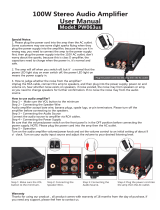
Connections
6
tape deck or other analog source component. Select the corresponding input on the front of the iNova to listen.
To connect a turntable you’ll need an external phono preamplier. (Some turntables have a phono preamplier
built in and can be connected directly to an iNova aux input.) We recommend you consult your dealer for
recommendations on properly hooking up your turntable to the iNova. HT Bypass: See the Back Panel page
of this manual (page 5) for instructions on using the iNova in Home Theater Bypass mode.
• Component Video Out: This allows a high-resolution pass-through of a video signal from your iPod. Using
a set of component video cables, connect to the component video inputs of a television, A/V receiver or A/V
preamp/processor. Video quality will be dependent upon the quality of the video program stored on your iPod.
• Speaker Output: Connect your speakers to the left and right speaker terminals of the iNova using high quality
speaker wire. Be sure to observe correct polarity when you make your connections. Connect the “+” terminal
on each speaker to the corresponding “+” terminal on the iNova; likewise for the “-” terminals. Do not let stray
strands of speaker wire from one terminal touch another terminal or another wire. The iNova is designed to
drive one pair of speakers with a rated output impedance of between 4 and 8 ohms. It is not advisable to use
more than one pair of speakers with the iNova.
• Pre Out: The stereo preamplier output provides exibility in maximizing the performance of your iNova-
based audio system:
To connect an external amplier:
The iNova does not limit you to using its internal amplier. You may connect a more powerful external amplier
to drive your speakers - provided your speakers can handle the extra power. (If you have a question
regarding suitability of a particular amplier for your speakers please consult your dealer.) Be sure the iNova
and the external amplier are both turned off. Connect a stereo RCA cable from the iNova “Pre Out” jacks to the
stereo RCA inputs of the external amplier; connect your speaker wires to the speaker terminals of the external
amplier. To listen to music turn on the iNova rst, then the external amplier; reverse this sequence when turning
the system off. You are now using the iNova as a high quality digital and analog preamplier.
To connect a powered subwoofer:
If you are using a subwoofer that accepts a “line in” connection from your amplier, connect a stereo RCA cable
from the iNova “Pre Out” jacks to the subwoofer stereo input jacks. If your subwoofer has only one “line in” jack,
you may use a single RCA cable from either the left or right iNova “Pre Out” jack. Even with this single-cable
hookup you will lose little or no musical information, since most recordings mix bass frequencies in mono.
To connect both an external amplier and powered subwoofer:
Use Y adapters from the iNova “Pre Out” jacks to simultaneously send the audio signal to both an external
amplier and a powered subwoofer.
• Line Out: Thanks to its state-of-the art ESS Sabre DAC technology the xed-level line output of the iNova
allows it to serve as a high-end digital to analog converter in any existing audio system. Connect the iNova’s
left and right line out jacks to line-level inputs of the system. Select any connected digital source from the
front panel of the iNova or from the iNova remote control. Set your listening level using your existing system’s
volume control.
WARNING: DO NOT CONNECT THIS FIXED-LEVEL LINE OUTPUT TO A PHONO INPUT OR DIRECTLY
TO THE INPUTS OF A POWER AMPLIFIER. YOU WILL LIKELY DAMAGE YOUR PREAMPLIFIER,
RECEIVER, POWER AMPLIFIER AND SPEAKERS!
• USB Digital Input: Connect the USB output from a computer (or
other source component which can output audio via USB) using a USB
cable. Select this input on the front of the iNova to listen.
• Coaxial Digital Inputs: Connect the coaxial output from any digital
source, using a coaxial digital cable. Select the corresponding input on
the front of the iNova to listen to your connected source component.
• Optical Digital Inputs (sometimes called Toslink): Connect the
optical output from any digital source, using an optical digital cable.
Select the corresponding input on the front of the iNova to listen to your
connected source component.
• Aux Inputs: Connect the left and right channel outputs from a tuner,

















